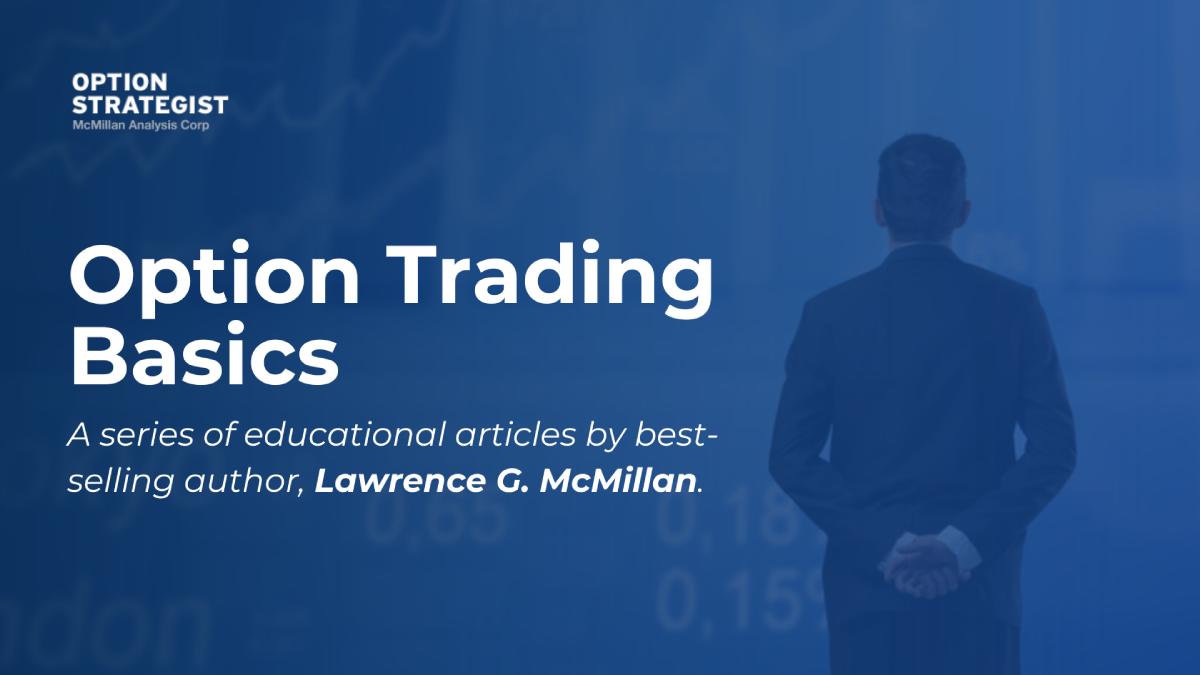
By Lawrence G. McMillan
This article was originally published in The Option Strategist Newsletter Volume 5, No. 9 on May 9, 1996.
The concept of volatility, and especially implied volatility is extremely important for option traders. We often refer to implied volatility, for it is the foundation of many of our strategies. However, when meeting the public, I find that many people don't have a clear concept of what implied volatility is, so this article will be educational for some readers, and merely review for others.
Volatility is a measure of how fast something changes in price. If one is looking at past prices and using them to calculate volatility (which can be done with simple statistics), then he is calculating historical volatility. However interesting historical volatility might be, it is only a rough guide as to how fast prices might change in the future. In reality, there is no way to know how fast prices will change in the coming days, weeks or months, but option traders must make a "guess" at that future volatility in order to assign values to today's options.
Option prices are determined by five main factors: the price of the underlying, the striking price, the time remaining until expiration, short-term interest rates, and volatility. The first four of these are well-defined and known at any point in time. Thus, only volatility is unknown, and must therefore be estimated by market makers and traders in order to price options. This estimate, or "guess", of impending volatility is the implied volatility.
There is another way to define implied volatility, and this way sometimes appeals to the more mathematically inclined. Suppose that we know that IBM is 119, and that the May 120 call is trading at 5½. Thus we know that the stock price is 119, the strike price is 120, there are 6 weeks until June expiration, and short-term interest rates are 5.75%. If we are using a mathematical model to value this IBM option, the question we must then ask is "What volatility do I need to plug into my model — along with these other known factors — in order to make the model give a theoretical value of 5½?" Whatever that volatility is (36.3% in this example), it is the implied volatility.
The most important use of implied volatility is to give us some gauge as to whether options are currently cheap, fairly priced, or expensive. Of course, it's all relative since the options are trying to predict future volatility and no one knows for sure what that's going to be. It's not just as simple as saying "sell options when implied volatility is high, and buy them when it is low". However, by making relative comparisons, we can gainfully use implied volatility in option trading decisions.
For example, suppose that we see that implied volatility has suddenly spiked to extremely high levels — levels that are previously unheard of. We would interpret this as meaning that there are very aggressive buyers of the options. If there has been some extraordinary news released, this might account for such action, but more likely this type of action means that there is a rumor around (perhaps of a takeover). In this situation, we would not want to sell options (even though the implied volatility is extremely high), for it is likely that someone is using inside information to buy the options for extreme leverage. Implied volatility situations of this type are listed in each issue of this newsletter along with the Volume Alerts (page 8).
In more normal situations, one can use the implied volatility to help him decide whether to establish option strategies that are composed predominantly of long options or short (naked) options. Again, however, one must be careful how he interprets the data. For example, if I told you that there was a situation in which implied volatility was 12% and historical volatility was 7%, what would you prefer: option buying strategies or option selling strategies? You might think that you should say "selling strategies", but that wouldn't be correct.
The correct answer, at this point, is "Neither. You haven't given me enough information upon which to make a decision!" Suppose, then, that I expanded the information: implied volatility has previously ranged between 11% and 22% and it's now at 12%, while historical volatility has ranged between 7% and 17% and it's now at 7%. Now, what do you think? "Buying strategies" are the favored strategies, because both historical and implied volatilities are near the bottom of their traditional ranges. In fact, these were actual volatility figures of OEX options, and the implied volatility of OEX options is typically higher than its historical volatility. So you can't make the assumption that implied and historical volatilities will always converge. The above OEX data occurred near the beginning of 1995, just before the market exploded upward for months. It was indeed a time to buy options, not to sell them.
Thus, one should look for option buying strategies when implied volatility is near the low end of its traditional range and should look for option selling strategies when it is near the top of its range (provided, of course, that one does not suspect that implied volatility is high because of illegal insider trading). This is the information that is in the "Volatility Trading" table in each issue.
This article was originally published in The Option Strategist Newsletter Volume 5, No. 9 on May 9, 1996.
© 2023 The Option Strategist | McMillan Analysis Corporation

